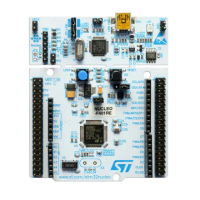RM0401 Rev 3 363/771
RM0401 General-purpose timers (TIM5)
389
Let’s use TI2FP2 as trigger 1:
• Map TI2FP2 on TI2 by writing CC2S=01 in the TIMx_CCMR1 register.
• TI2FP2 must detect a rising edge, write CC2P=0 and CC2NP=’0’ in the TIMx_CCER
register.
• Configure TI2FP2 as trigger for the slave mode controller (TRGI) by writing TS=110 in
the TIMx_SMCR register.
• TI2FP2 is used to start the counter by writing SMS to ‘110 in the TIMx_SMCR register
(trigger mode).
The OPM waveform is defined by writing the compare registers (taking into account the
clock frequency and the counter prescaler).
• The t
DELAY
is defined by the value written in the TIMx_CCR1 register.
• The t
PULSE
is defined by the difference between the auto-reload value and the compare
value (TIMx_ARR - TIMx_CCR + 1).
• Let’s say one want to build a waveform with a transition from ‘0 to ‘1 when a compare
match occurs and a transition from ‘1 to ‘0 when the counter reaches the auto-reload
value. To do this PWM mode 2 must be enabled by writing OC1M=111 in the
TIMx_CCMR1 register. Optionally the preload registers can be enabled by writing
OC1PE=1 in the TIMx_CCMR1 register and ARPE in the TIMx_CR1 register. In this
case one has to write the compare value in the TIMx_CCR1 register, the auto-reload
value in the TIMx_ARR register, generate an update by setting the UG bit and wait for
external trigger event on TI2. CC1P is written to ‘0 in this example.
In our example, the DIR and CMS bits in the TIMx_CR1 register should be low.
Since only 1 pulse (Single mode) is needed, a 1 must be written in the OPM bit in the
TIMx_CR1 register to stop the counter at the next update event (when the counter rolls over
from the auto-reload value back to 0). When OPM bit in the TIMx_CR1 register is set to '0',
so the Repetitive Mode is selected.
Particular case: OCx fast enable:
In One-pulse mode, the edge detection on TIx input set the CEN bit which enables the
counter. Then the comparison between the counter and the compare value makes the
output toggle. But several clock cycles are needed for these operations and it limits the
minimum delay t
DELAY
min we can get.
If one wants to output a waveform with the minimum delay, the OCxFE bit can be set in the
TIMx_CCMRx register. Then OCxRef (and OCx) is forced in response to the stimulus,
without taking in account the comparison. Its new level is the same as if a compare match
had occurred. OCxFE acts only if the channel is configured in PWM1 or PWM2 mode.
15.3.11 Encoder interface mode
To select Encoder Interface mode write SMS=‘001 in the TIMx_SMCR register if the counter
is counting on TI2 edges only, SMS=010 if it is counting on TI1 edges only and SMS=011 if
it is counting on both TI1 and TI2 edges.
Select the TI1 and TI2 polarity by programming the CC1P and CC2P bits in the TIMx_CCER
register. When needed, the input filter can be programmed as well.
The two inputs TI1 and TI2 are used to interface to an incremental encoder. Refer to
Table 61. The counter is clocked by each valid transition on TI1FP1 or TI2FP2 (TI1 and TI2
after input filter and polarity selection, TI1FP1=TI1 if not filtered and not inverted,

